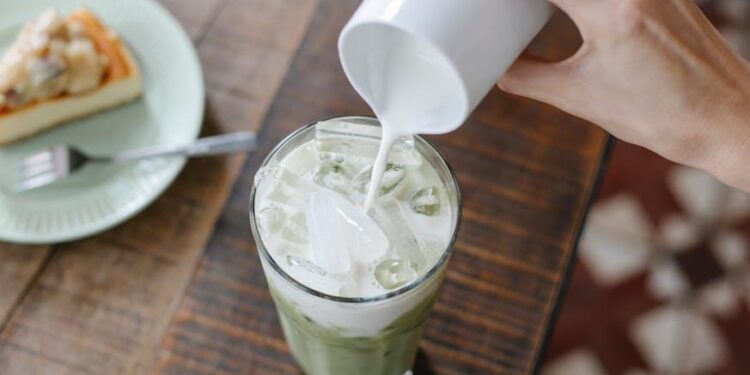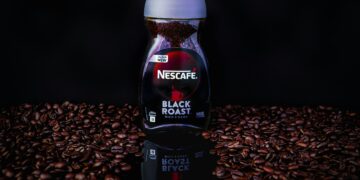Table of Contents
My Most Humiliating Cup of Coffee
Let me be clear: I was a coffee purist.
My kitchen counter is a testament to this obsession, a carefully curated altar to the bean.
It features a high-precision burr grinder, a gooseneck kettle with digital temperature control, an AeroPress, a French press, and a collection of single-origin beans that I track with the fervor of a stock market analyst.
I speak the language of extraction yields, bloom times, and tasting notes.
So, you can imagine my quiet horror when, on a family visit to a remote cabin, I awoke to find the sole source of caffeine was a squat glass jar of instant coffee.
My choices were stark: a caffeine headache or a pact with the devil.
I chose the latter.
Confident in my superior coffee knowledge, I boiled the kettle, spooned a heap of the dark, dusty granules into a mug, and poured the scalding water over top.
The result was an abomination.
It was a thin, acrid, brutally bitter liquid that tasted of burnt plastic and despair.
It was, without exaggeration, the most humiliating cup of coffee I had ever made.
My family, bless them, drank it without complaint, but I saw the quiet pity in their eyes.
My carefully constructed identity as the “coffee guy” had been shattered by a teaspoon of powder.
That failure gnawed at me.
It wasn’t just about the bad taste; it was about the gap in my knowledge.
I had dismissed instant coffee as a lost cause, an irredeemable product for the undiscerning palate.1
But was it truly beyond saving? Or was I, the purist, the one who was fundamentally misunderstanding it? This question launched me on a journey that would take me far beyond the world of coffee and into the foundational principles of flavor itself, leading to an epiphany that would forever change how I view that humble jar.
Part 1: The Anatomy of a Bad Brew – Why We Secretly (or Openly) Despise Instant Coffee
To solve my problem, I first had to understand it.
My investigation began not with brewing techniques, but with history.
I needed to know where this product came from, because its origin story, I discovered, is the root cause of its flawed reputation.
The Ghost of Rations Past: A Legacy of Convenience, Not Quality
Instant coffee wasn’t born in a cozy Italian café; it was engineered for the battlefield.
While the first patent for a “coffee compound” was granted in Britain in 1771, and experimental “cakes” of coffee were given to soldiers during the American Civil War, its modern form is a product of 20th-century industrial pragmatism.3
An inventor named George Constant Louis Washington (no relation to the president) began mass-producing the first commercial instant coffee in 1909 after observing coffee powder that had collected on the spout of a silver coffee P.T.3
Though a commercial first, its taste was widely considered unsatisfactory.6
Its big break came with war.
During World War I, the U.S. military bought up the entire supply, and soldiers affectionately dubbed it a “cup of George”.3
The product’s true purpose was cemented: it was designed for portability, long shelf life, and ease of use in the most challenging conditions imaginable—flavor was a distant afterthought.7
This identity was further solidified in the 1930s.
The Brazilian Coffee Institute, facing a massive surplus of coffee beans that couldn’t be exported, approached the Nestlé company with a problem: create a soluble coffee product to preserve the harvest and boost sales.3
After seven years of research, chemist Max Morgenthaler developed a new powder, and in 1938, Nescafé was born.8
It was an immediate commercial success, and with the outbreak of World War II, it once again became a critical component of every U.S. soldier’s emergency rations.7
This history reveals a crucial truth.
The “bad taste” of instant coffee isn’t an accident; it’s a direct consequence of its original design parameters.
The primary goals were never nuance, aroma, or complexity.
They were shelf stability and convenience.
This foundational purpose dictated every subsequent choice, from the raw materials to the manufacturing process.
To be cost-effective for mass production and military contracts, manufacturers naturally gravitated toward cheaper, hardier Robusta beans instead of the more aromatic but delicate Arabica beans.9
To produce it on an industrial scale, they invented high-heat processes optimized for speed and volume.9
The resulting flavor profile—bitter, flat, and often burnt—is a direct, inherited trait from a legacy where survival, not sensory pleasure, was the objective.
The Science of “Stale”: Deconstructing the Flavor Flaws
My historical deep dive explained the “why,” but I still needed to understand the “how.” The characteristic bitterness and lack of aroma in my humiliating cup were the result of specific chemical and physical processes.
First is the Robusta Problem.
The coffee world is dominated by two main species: Arabica and Robusta.
Arabica beans are prized for their complex, aromatic, and fruity notes with a pleasant acidity.
Robusta beans are, as the name implies, more robust.
They are easier to grow, contain nearly double the caffeine, and have a much harsher, more bitter, and rubbery flavor profile.9
Because they are cheaper and their strong flavors can better withstand the harsh manufacturing process, Robusta beans became the default choice for most mass-market instant coffees.9
While a growing number of specialty brands now use 100% Arabica, the taste many of us associate with instant coffee is the taste of Robusta.7
Second is the Drying Dilemma.
To get from a liquid coffee brew to a dry powder, manufacturers use one of two main methods, and the difference between them is night and day for the final flavor.9
- Spray-Drying: This is the older, faster, and cheaper method. A liquid coffee concentrate is sprayed as a fine mist into a chamber of extremely hot air, with temperatures reaching around 415°F (212°C).9 As the droplets fall, the water evaporates, leaving a fine powder. This intense heat is destructive. It burns off most of the volatile organic compounds that give coffee its beautiful aroma and nuanced flavor, leaving behind a product that is often described as bitter, burnt, or stale.11
- Freeze-Drying: This is a more modern and gentle process that better preserves flavor. The coffee extract is first frozen to a solid block at around -40°C (-40°F). This block is then broken into granules and placed in a strong vacuum. In the vacuum, the frozen water turns directly into vapor without ever becoming liquid again—a process called sublimation.10 Because it avoids the flavor-killing high temperatures of spray-drying, freeze-drying results in a markedly smoother, more full-bodied, and aromatic coffee.7
Finally, there are the Chemical Culprits.
The bitterness I tasted is caused by real chemical compounds.
Molecules like chlorogenic acids and trigonelline are naturally present in coffee, but the combination of Robusta beans (which have more of them) and high-temperature processing methods over-extracts them, making their bitter taste dominate the cup.14
Table 1: The Instant Coffee Quality Matrix: What to Look For on the Label
This investigation made it clear that not all instant coffees are created equal.
The problem is that most of us don’t know what to look for.
The packaging all looks similar, but the clues to quality are there if you know the code.
This matrix translates the science into a simple shopping guide.
| Feature | Lower Quality (Avoid) | Higher Quality (Seek Out) | Why It Matters |
| Drying Method | “Spray-Dried” or Unspecified | “Freeze-Dried” | Freeze-drying preserves delicate flavors and aromas; spray-drying’s high heat burns them off, leading to a bitter, weaker taste.12 |
| Bean Type | Robusta or Unspecified Blend | “100% Arabica” | Arabica beans are naturally smoother, sweeter, and more aromatic. Robusta beans are harsher, more bitter, and have a rubbery aftertaste.7 |
| Appearance | Fine, dark, inconsistent powder; often clumpy | Uniform, lighter-colored granules | Freeze-dried granules are typically more distinct and less “powdery” than their spray-dried counterparts, which can have a sludgy texture.15 |
| Descriptors | “Classic,” “Rich Roast,” “Intense” | “Single Origin,” “Micro-ground,” “Specialty” | Language focused on origin or craft indicates a higher commitment to quality over mass-market appeal and cost-effectiveness.6 |
Part 2: The “Mirepoix” Epiphany – A Chef’s Approach to Coffee
Armed with this new knowledge, I could now buy a better jar of instant coffee.
But I still hadn’t solved the core problem of preparation.
Even the best freeze-dried Arabica could be ruined by poor technique, as I had so painfully demonstrated.
My research hit a wall until, in a moment of frustration, I stepped away from coffee blogs and fell down a rabbit hole of culinary science.
That’s when I found it: the concept that would change everything.
I stumbled upon the idea of a flavor base.
Cuisines all over the world are built on this principle.
In French cooking, it’s the mirepoix: a combination of onion, carrot, and celery slowly sautéed in butter or oil.16
In Spanish and Latin American cuisine, it’s the
sofrito: garlic, onion, and tomato forming the foundation of countless dishes.18
In Cajun and Creole cooking, it’s the “Holy Trinity” of onion, bell pepper, and celery.17
These aren’t just lists of ingredients; they represent a fundamental technique.
The aromatics are finely chopped and cooked slowly in a fat, not to brown them, but to gently coax out their water-soluble and fat-soluble flavor compounds, creating a deep, complex, and harmonious foundation upon which the rest of the dish is built.18
You wouldn’t make a great soup by just tossing a dried mirepoix mix into a pot of boiling water and hoping for the best.
You would rehydrate it carefully, bloom its flavors in fat, and build upon it layer by layer.
And that was the epiphany.
The lightning bolt moment.
We have all been treating instant coffee like a simple seasoning, like a sugar cube or a pinch of salt.
The instruction is always “just add hot water”.3
But instant coffee isn’t a simple soluble powder.
A coffee bean is a complex cellular structure holding a vast array of compounds—fruit acids, lipids, melanoidins, carbohydrates—that dissolve at different rates.20
An instant coffee granule is a hyper-concentrated, dehydrated, and extremely delicate form of these extracted compounds.22
The fundamental error we all make is a misunderstanding of its physical state.
We think we are dissolving a powder when we should be rehydrating a concentrate.
Hitting those fragile, porous granules with boiling water is the thermal equivalent of throwing minced garlic into a ripping hot, dry pan.
You don’t get fragrant, sweet garlic; you get scorched, bitter, acrid garlic.
The outside burns before the inside has a chance to cook.
My humiliating cup of coffee wasn’t just bad; it was scorched.
The correct approach, inspired by the wisdom of chefs, had to be a gentle, controlled rehydration—a “blooming” of the concentrate—before building the final drink.
Part 3: The “Coffee Base” Method: A 3-Step System to Flawless Instant Coffee
This epiphany gave rise to a new system, which I call the “Coffee Base” method.
It transforms the act of making instant coffee from a simple mix into a deliberate culinary technique.
It organizes all the disparate “hacks” and “tips” I found in my research into a coherent, repeatable workflow that directly counteracts the inherent flaws of the product.
These aren’t just tricks to make coffee taste better; they are a form of culinary first aid, a targeted intervention against the damage done during manufacturing.
Step 1: The Cold Slurry (The Foundation)
This is the most critical and non-negotiable step.
It is our “Mirepoix” moment.
- The Technique: In your mug, combine your instant coffee granules with a very small amount of cold or room-temperature water. You can also use milk or cream.24 Use just enough liquid—typically a tablespoon or two—to wet the granules, and stir until they have completely dissolved into a smooth, thick paste or slurry.24 There should be no dry clumps remaining.
- The Science: This simple action prevents what baristas call “thermal shock”.25 By gently and evenly rehydrating the delicate, porous coffee concentrate in a cold liquid first, you allow the soluble compounds to dissolve without being scorched. This preserves the subtle aromatic notes that would otherwise be destroyed by the violent application of boiling water, resulting in a dramatically smoother and less bitter foundation.
Step 2: The Flavor Modulators (The Aromatics)
With our coffee concentrate properly rehydrated, we now have a stable base to build upon.
This is the stage to season and balance the flavor profile before diluting it.
- The Technique: Add your flavor modulators directly to the coffee slurry and stir them in.
- The Salt Hack: This is the most powerful tool in your arsenal. Add a tiny pinch of salt—we’re talking a few grains, not enough to taste salty. The sodium ions in the salt work on a neurological level, effectively binding to the taste receptors on your tongue that perceive bitterness, thus blocking the bitter signal from reaching your brain.14 The result is a coffee that tastes rounder, smoother, and even slightly sweeter.
- Sweeteners and Spices: This is the perfect time to add and fully dissolve any sugar, honey, maple syrup, or other sweeteners.28 The concentrated paste ensures they integrate completely, avoiding any grittiness. It’s also the ideal medium to “bloom” powdered spices like cinnamon, nutmeg, cardamom, or cocoa powder, infusing their flavor deeply into the base.14
Step 3: The Liquid (The Body)
Only after the foundation has been built and seasoned do we add the bulk liquid to create the final drink.
- The Technique: Slowly pour your primary liquid into the coffee base, stirring as you go.
- Water Temperature is Critical: The water should be hot, but never boiling. The ideal temperature range for coffee extraction is between 195°F and 205°F (90°C and 96°C).26 Pouring boiling water (212°F / 100°C) will still manage to scorch some of the delicate compounds and over-extract the bitter ones. A simple rule of thumb: let your kettle come to a boil, then turn it off and wait 30 to 60 seconds before pouring.
- Milk and Alternatives: If making a hot latte-style drink, use hot milk. A professional barista tip is that heating milk to around 140°F (60°C) makes it taste sweeter and integrates better, whereas adding cold milk to hot coffee can mute the flavors and cause a drastic temperature drop.12 For iced drinks, you can simply pour your finished coffee base over a glass of ice and cold milk.
Part 4: The Recipe Playbook: Applying the “Coffee Base” Method
The true beauty of the Coffee Base method is its versatility.
Once you master the three steps, you can create an endless variety of delicious drinks that rival those from a coffee shop.
Here is a playbook to get you started.
Every single recipe begins with the 3-step method.
The Foundational Recipes
These two recipes showcase the power of the method in its purest form.
- The Perfect Black Coffee: This is the ultimate test. It proves that with the right technique, even the simplest instant coffee can be smooth, balanced, and enjoyable.
- Base: In a mug, combine 1-2 teaspoons of freeze-dried instant coffee, a tiny pinch of salt, and 1 tablespoon of cold water. Stir into a smooth slurry.
- Liquid: Slowly pour in 6-8 ounces of hot water (195-205°F). Stir and enjoy.
- The Ultimate No-Dilution Iced Coffee: This recipe solves the age-old problem of watery iced coffee. The secret is making coffee ice cubes ahead of time.
- Ice Cubes: Prepare a batch of instant coffee using the Coffee Base method and pour it into an ice cube tray. Freeze overnight.34
- Base: In a tall glass, prepare a concentrated coffee base: 2 teaspoons instant coffee, a pinch of salt, 1 teaspoon sugar (optional), and 1 tablespoon of cold water. Stir into a slurry.
- Liquid: Fill the glass with your prepared coffee ice cubes, then top with cold milk or a mix of milk and water.
Café-Style Creations
Recreate your favorite coffee shop drinks for a fraction of the price.
- The Dalgona Deconstructed (Whipped Coffee): This viral sensation is simply an aerated, sweetened version of the coffee base.
- Base: In a mixing bowl, combine 2 tablespoons of instant coffee, 2 tablespoons of sugar, and 2 tablespoons of hot water. (The heat helps dissolve the sugar for a stable foam). Whip with a hand mixer or whisk for 3-4 minutes until it forms light, creamy, stiff peaks.11
- Liquid: Fill a glass with ice and cold milk. Spoon the whipped coffee cloud on top.
- The 30-Second Mocha: Rich, chocolatey, and incredibly fast.
- Base: In a mug, combine 2 teaspoons instant coffee, 1 tablespoon cocoa powder, 2 teaspoons sugar, and a pinch of salt. Add 2 tablespoons of hot water or milk and stir into a smooth chocolate-coffee paste.36
- Liquid: Top with 6-8 ounces of steamed milk. Garnish with whipped cream if desired.
- The Spiced Caramel Frappé: A frosty, blended treat.
- Base: In a blender, combine 2 teaspoons instant coffee, 1 tablespoon caramel sauce, ¼ teaspoon cinnamon, a pinch of salt, and 2 tablespoons of milk.
- Liquid & Blend: Add 6 ounces of cold milk and 1 cup of ice to the blender. Blend until smooth and frosty.35
Adventurous Pairings
Push the boundaries with these creative combinations.
- Orange-Zest Shaken “Espresso”: A bright, aromatic, and foamy iced drink.
- Base: Prepare a coffee base in a cocktail shaker: 2 teaspoons instant coffee, 2 teaspoons brown sugar, a dash of cinnamon, and 2 tablespoons of water. Stir to dissolve.
- Liquid & Shake: Add a large strip of orange zest and a cup of ice to the shaker. Seal and shake vigorously for 30 seconds until a thick foam develops. Strain into a glass filled with fresh ice and top with cold milk.40
- Vietnamese-Style Sweet Cream Coffee: A decadent and powerful iced coffee.
- Base: In a glass, prepare a strong coffee base: 2-3 teaspoons instant coffee and 2 tablespoons of hot water. Stir until dissolved.
- Liquid: Stir 1-2 tablespoons of sweetened condensed milk into the coffee base until fully combined. Fill the glass with ice and top with a splash of milk or water to your desired strength.36
Table 2: The Coffee Base Recipe Blueprint
Use this table as a quick-reference guide to reinforce the methodology and inspire your own creations.
| Drink Name | Base Ingredients (Steps 1 & 2) | Primary Liquid (Step 3) | Key Technique |
| Perfect Black Coffee | 1-2 tsp coffee, pinch of salt, 1 tbsp cold water | 6-8 oz hot water (195-205°F) | Simple cold slurry to prevent bitterness. |
| Ultimate Iced Coffee | 2 tsp coffee, pinch of salt, 1 tbsp cold water | Cold milk | Serve over pre-made coffee ice cubes to avoid dilution. |
| Dalgona Coffee | 2 tbsp coffee, 2 tbsp sugar, 2 tbsp hot water | Cold milk | Whip base ingredients with a mixer until stiff peaks form. |
| 30-Second Mocha | 2 tsp coffee, 1 tbsp cocoa, 2 tsp sugar, pinch salt, 2 tbsp hot water/milk | 6-8 oz steamed milk | Create a chocolate-coffee paste before adding hot milk. |
| Spiced Caramel Frappé | 2 tsp coffee, 1 tbsp caramel, ¼ tsp cinnamon, pinch salt, 2 tbsp milk | 6 oz cold milk, 1 cup ice | Combine all ingredients in a blender and blend until smooth. |
| Orange Shaken | 2 tsp coffee, 2 tsp brown sugar, dash cinnamon, 2 tbsp water | Cold milk | Shake base with ice and orange zest before topping with milk. |
| Vietnamese Style | 2-3 tsp coffee, 2 tbsp hot water | Sweetened condensed milk, ice | Stir sweetened condensed milk directly into the strong coffee base. |
Part 5: Your Lingering Questions, Answered (The Expert FAQ)
My journey transformed my perspective, but it also raised several practical questions.
Here are the answers to some of the most common ones.
Is instant coffee really that popular? I thought everyone was a coffee snob now.
This is what I call the “Great Coffee Disconnect.” While specialty coffee shops and at-home brewing have exploded in North America and parts of Europe, creating a culture of coffee snobbery, the global picture is vastly different.
Instant coffee is a giant.
It accounts for more than 34% of all retail brewed coffee consumed around the world.43
In the UK, a staggering 80% of households buy instant coffee, and it remains the number one choice for a majority of the population.43
In Australia, it accounts for over 75% of retail coffee consumption.43
The Asia-Pacific region is the world’s largest market, with countries like India and China driving massive growth.6
For many cultures, especially those with a strong tea tradition or a more recent adoption of coffee, instant’s convenience and accessibility make it the default entry point into the coffee world.43
So while a millennial in the U.S. might shun it, it’s the daily brew for hundreds of millions of people globally.47
I’ve heard instant coffee is unhealthy. What’s the deal with acrylamide and those new eye-health studies?
This is an important question that requires a balanced, non-alarmist answer.
The health concerns around instant coffee reinforce the central theme of this article: the industrial processing is the source of its flaws, both in taste and in chemistry.
- Acrylamide: This is a chemical compound that forms in many starchy foods during high-temperature cooking processes like frying, baking, and roasting.13 It’s in potato chips, bread, and all roasted coffee. Studies show that instant coffee can contain up to twice the amount of acrylamide as regular brewed coffee, a direct result of the high-heat processing.13 However, health agencies emphasize that the levels consumed in a normal diet are far, far lower than the high doses shown to cause cancer in animal studies, and the link to cancer in humans is not well-established.49 The consensus is that for moderate consumption, the risk is minimal.
- AMD and Telomeres: More recently, genetic studies have made headlines by linking high consumption of instant coffee (but not other types) to an increased risk of Age-Related Macular Degeneration (AMD), a leading cause of vision loss, and to shorter telomeres, a biomarker of cellular aging.51 These studies are new and often show a genetic correlation rather than direct causation. Researchers theorize that byproducts from the intense processing, such as Advanced Glycation End-products (AGEs) and oxidized lipids—which are not as prevalent in fresh brews—may be responsible.51 This doesn’t mean your next cup is a danger, but it does suggest that moderation is wise and reinforces the idea that instant coffee is a highly processed food that should be treated as such.
Does instant coffee have less caffeine?
Yes, as a general rule, it does.
An average 8-ounce cup of instant coffee typically contains between 60-85 mg of caffeine.
The same size cup of regular drip-brewed coffee usually has between 75-125 mg.13
For people who are sensitive to caffeine, this can be a significant advantage.
For those seeking a powerful kick, it might be a drawback, potentially leading them to drink more cups than they otherwise would.13
So, what brand should I actually buy?
While I won’t endorse a single brand, the rule is simple: read the label.
Refer back to the Quality Matrix in Part 1.
Your best bet for a better-tasting experience is to choose a product that is explicitly labeled “freeze-dried” and “100% Arabica”.7
The rise of the specialty coffee movement is also elevating the category, with high-end roasters like Blue Bottle now producing premium instant coffees that even professional baristas recommend, designed to mimic true espresso.25
This shows that the industry itself is starting to recognize the potential beyond cheap, spray-dried Robusta.
Conclusion: The Convert’s Pantry
My journey began with a single, terrible cup of coffee and a dose of humility.
It forced me to question my own dogmas and look at a despised ingredient with fresh eyes.
Today, my kitchen counter still holds its place as an altar to specialty coffee.
But now, in the pantry, a jar of high-quality, freeze-dried instant coffee sits proudly next to the whole beans.
It’s no longer a symbol of failure or compromise.
It’s a tool.
It’s my secret weapon for a delicious iced latte in 60 seconds, my go-to for a quick and satisfying cup when I’m short on time, and my key ingredient for coffee-flavored desserts.
The transformation wasn’t about lowering my standards; it was about raising my understanding.
By borrowing a fundamental secret from the world of culinary arts—the flavor base—I learned to deconstruct, rebuild, and ultimately master this humble, misunderstood product.
The most profound lesson is this: there are few truly bad ingredients, only flawed techniques.
With the right knowledge and a simple shift in perspective, we can unlock hidden potential and transform the mundane into something genuinely delightful.
It was never about the coffee; it was about how I was making it.
And that is a lesson that extends far beyond the kitchen.
Works cited
- Why is instant coffee bad? : r/IndiaCoffee – Reddit, accessed August 7, 2025, https://www.reddit.com/r/IndiaCoffee/comments/16iegef/why_is_instant_coffee_bad/
- What’s the deal with instant coffee? : r/Cooking – Reddit, accessed August 7, 2025, https://www.reddit.com/r/Cooking/comments/xkiokg/whats_the_deal_with_instant_coffee/
- History of Instant Coffee, accessed August 7, 2025, https://espressocoffeeguide.com/instant-coffee/history-of-instant-coffee/
- Instant coffee – Wikipedia, accessed August 7, 2025, https://en.wikipedia.org/wiki/Instant_coffee
- The First Instant Coffee – History of Coffee, accessed August 7, 2025, https://www.historyofcoffee.net/coffee-history/instant-coffee-history/
- The History of Instant Coffee, accessed August 7, 2025, https://www.nationwidecoffee.co.uk/news/the-history-of-instant-coffee
- How Instant Coffee Has Evolved – Buencafe, accessed August 7, 2025, https://www.buencafe.com/how-instant-coffee-has-evolved/
- The fascinating history of NESCAFÉ – Nescafe, accessed August 7, 2025, https://www.nescafe.com/mena/en-ae/coffee-culture/coffee-knowledge/nescafe-story
- How is Instant Coffee Made? A Step-by-Step Look – CAFELY, accessed August 7, 2025, https://cafely.com/blogs/info/how-is-instant-coffee-made
- How to Make Instant Coffee at Home – Coffee Bean Corral, accessed August 7, 2025, https://www.coffeebeancorral.com/blog/post/making-instant-coffee
- How is Instant Coffee Powder Made? – FoodUnfolded, accessed August 7, 2025, https://www.foodunfolded.com/article/how-is-instant-coffee-powder-made
- 11 Mistakes You’re Making With Instant Coffee – Tasting Table, accessed August 7, 2025, https://www.tastingtable.com/1545351/mistakes-instant-coffee/
- Is Instant Coffee Bad for You? The Truth Behind Just Add Water, accessed August 7, 2025, https://peakstatecoffee.com/blogs/peak-state/is-instant-coffee-bad-for-you
- How do you remove bitterness from instant coffee – JavaPresse, accessed August 7, 2025, https://www.javapresse.com/blogs/enjoying-coffee/how-do-you-remove-bitterness-from-instant-coffee
- 9 Instant Coffee Brands, Ranked Worst To Best – Tasting Table, accessed August 7, 2025, https://www.tastingtable.com/1755382/instant-coffee-brands-ranked-worst-best/
- The Foundation of Flavor: A Guide to Culinary Bases from Around the World, accessed August 7, 2025, https://thespicegirlkitchen.com/foundation-of-flavor/
- More than Mirepoix: 4 Culinary Bases to Master – Munchery, accessed August 7, 2025, https://www.munchery.com/blog/mirepoix-bases-to-master-in-home-cooking/
- Flavor Bases Give You Scratch Cook Confidence – Health Food Radar, accessed August 7, 2025, https://healthfoodradar.com/flavor-base-cooking/
- How to create a Flavor Base (and make something out of whatever’s in your kitchen) – Reddit, accessed August 7, 2025, https://www.reddit.com/r/Cooking/comments/fl17ks/how_to_create_a_flavor_base_and_make_something/
- Coffee Extraction Explained, accessed August 7, 2025, https://www.drivencoffee.com/blogs/blog/coffee-extraction-explained
- An Intuitive Guide To Coffee Solubles, Extraction And TDS – Handground, accessed August 7, 2025, https://handground.com/grind/an-intuitive-guide-to-coffee-solubles-extraction-and-tds
- What is Instant Coffee – Nescafe, accessed August 7, 2025, https://www.nescafe.com/in/coffee-culture/knowledge/what-is-instant-coffee
- driftaway.coffee, accessed August 7, 2025, https://driftaway.coffee/instant/#:~:text=Instant%20Coffee%20is%20Made%20From%20Brewed%20and%20Dried%20Grounds&text=Instant%20coffee%20is%20made%20by,the%20leftover%2C%20soluble%20coffee%20grounds
- LPT: Dramatically and easily improve the flavor of instant coffee : r/LifeProTips – Reddit, accessed August 7, 2025, https://www.reddit.com/r/LifeProTips/comments/11a9njf/lpt_dramatically_and_easily_improve_the_flavor_of/
- I Asked 2 Baristas To Name the Best Instant Coffee—They Both Said the Same Brand, accessed August 7, 2025, https://www.simplyrecipes.com/best-instant-coffee-baristas-11776978
- How To Make the Best-Tasting Instant Coffee, accessed August 7, 2025, https://www.deathwishcoffee.com/blogs/coffee-talk/best-tasting-instant-coffee
- www.javapresse.com, accessed August 7, 2025, https://www.javapresse.com/blogs/enjoying-coffee/how-do-you-make-instant-coffee-taste-good-without-milk#:~:text=By%20adding%20just%20a%20pinch,need%20for%20milk%20or%20cream.
- How do you make instant coffee taste good without milk – JavaPresse, accessed August 7, 2025, https://www.javapresse.com/blogs/enjoying-coffee/how-do-you-make-instant-coffee-taste-good-without-milk
- Easy 1 Minute Instant Iced Coffee – Frosting and Fettuccine, accessed August 7, 2025, https://frostingandfettuccine.com/instant-iced-coffee/
- How to make black coffee taste better without any milk : r/vegan – Reddit, accessed August 7, 2025, https://www.reddit.com/r/vegan/comments/1f0tzmw/how_to_make_black_coffee_taste_better_without_any/
- Instant Gratification Mastering the Art of Making Instant Coffee at Home – JavaPresse, accessed August 7, 2025, https://www.javapresse.com/blogs/enjoying-coffee/instant-gratification-mastering-the-art-of-making-instant-coffee-at-home
- Top 5 Coffee Mistakes You’re Probably Making—And How to Fix Them, accessed August 7, 2025, https://www.cutterspoint.com/blog/coffee-brewing-mistakes
- How To Make Instant Coffee Taste Barista Level – YouTube, accessed August 7, 2025, https://www.youtube.com/watch?v=v7uHPx3TIkA
- 10 Ways to Make Your Instant Coffee ACTUALLY Taste Good – YouTube, accessed August 7, 2025, https://www.youtube.com/watch?v=zADIvF2c0-Q
- Instant Coffee Recipes: Lattes, Iced Drinks & More, accessed August 7, 2025, https://www.coffeeness.de/en/instant-coffee-recipes/
- How to make your instant coffee taste better than espresso – CHOICE, accessed August 7, 2025, https://www.choice.com.au/food-and-drink/drinks/tea-and-coffee/articles/how-to-make-instant-coffee-taste-good
- Quick and Tasty Instant Coffee Recipes You’ll Love – JoyJolt, accessed August 7, 2025, https://www.joyjolt.com/blogs/all_blogs/quick-and-tasty-instant-coffee-recipes-youll-love
- DIY iced (or hot) mocha recipe : r/Coffee – Reddit, accessed August 7, 2025, https://www.reddit.com/r/Coffee/comments/frvjvt/diy_iced_or_hot_mocha_recipe/
- Why your instant coffee sucks – YouTube, accessed August 7, 2025, https://www.youtube.com/watch?v=d1wa_1OdKpA
- NO MILK? NO PROBLEM! – MORE BUDGET-FRIENDLY INSTANT COFFEE RECIPES, accessed August 7, 2025, https://www.youtube.com/watch?v=wk-UqDRbL4Q
- How to make instant coffee #coffee – YouTube, accessed August 7, 2025, https://www.youtube.com/shorts/URkLnyQiVCY
- Any way to make instant coffee taste decent? – Reddit, accessed August 7, 2025, https://www.reddit.com/r/Coffee/comments/oqq0ff/any_way_to_make_instant_coffee_taste_decent/
- FASCINATING FACT: Do Most Consumers Actually Prefer Instant Coffee?, accessed August 7, 2025, http://www.spilling-the-beans.net/almost-half-of-the-world-actually-prefers-instant-coffee/
- Instant coffee trend growing | Fine Dining Lovers, accessed August 7, 2025, https://www.finedininglovers.com/article/instant-coffee-trend
- 20 Coffee Statistics That’ll Blow Your Mind | Nescafé | UK & IE – Nescafe, accessed August 7, 2025, https://www.nescafe.com/gb/coffee-culture/knowledge/coffee-statistics
- Instant coffee gaining prominence in tea-drinking cultures – Comunicaffe International, accessed August 7, 2025, https://www.comunicaffe.com/instant-coffee-gaining-prominence-tea-drinking-cultures/
- How Many People Drink Coffee? 11 Coffee Drinking Statistics, accessed August 7, 2025, https://joesgaragecoffee.com/blog/coffee-drinking-statistics/
- A third of Gen Z will ‘never drink instant coffee again’ – Coffee Intelligence, accessed August 7, 2025, https://intelligence.coffee/2023/03/gen-z-instant-coffee-uk-trends-covid/
- Instant Coffee and Acrylamide: Should You Be Worried? – McGill University, accessed August 7, 2025, https://www.mcgill.ca/oss/article/critical-thinking-student-contributors-health-and-nutrition/instant-coffee-and-acrylamide-should-you-be-worried
- Is Instant Coffee Bad for You? What Health Experts Say – EatingWell, accessed August 7, 2025, https://www.eatingwell.com/is-instant-coffee-bad-for-you-8382772
- Instant coffee may damage your eyes, genetic study finds – News-Medical.net, accessed August 7, 2025, https://www.news-medical.net/news/20250617/Instant-coffee-may-damage-your-eyes-genetic-study-finds.aspx
- Instant coffee tied to almost sevenfold higher risk of vision problems, study finds, accessed August 7, 2025, https://www.medicalnewstoday.com/articles/instant-coffee-age-related-macular-degeneration-risk
- Instant Coffee Is Negatively Associated with Telomere Length: Finding from Observational and Mendelian Randomization Analyses of UK Biobank – PubMed Central, accessed August 7, 2025, https://pmc.ncbi.nlm.nih.gov/articles/PMC10055626/
- Your instant coffee habit could be bad news – Rolling Out, accessed August 7, 2025, https://rollingout.com/2025/07/03/instant-coffee-habit-could-be-bad-news/
- Is Instant Coffee Bad for You? What to Consider Before Pouring Your Next Cup – GoodRx, accessed August 7, 2025, https://www.goodrx.com/well-being/diet-nutrition/is-instant-coffee-bad-for-you
- Mythbusting: Is Instant Coffee Bad for You? – IQBAR, accessed August 7, 2025, https://www.eatiqbar.com/blogs/news/mythbusting-is-instant-coffee-bad-for-you






